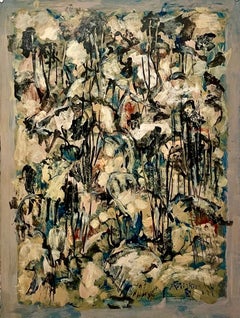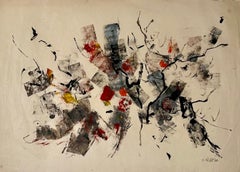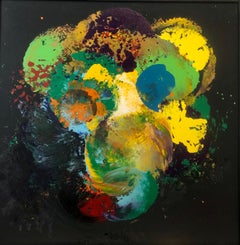Want more images or videos?
Request additional images or videos from the seller
1 of 9
Ramon PratsAbstract Expressionist Latin American Painting
Price:$1,200
About the Item
- Creator:Ramon Prats (1928 - 2003, Spanish)
- Dimensions:Height: 25.5 in (64.77 cm)Width: 21.5 in (54.61 cm)
- Medium:
- Movement & Style:
- Period:
- Condition:frame has wear, needs to be reframed.
- Gallery Location:Surfside, FL
- Reference Number:1stDibs: LU38212482582
About the Seller
4.9
Platinum Seller
Premium sellers with a 4.7+ rating and 24-hour response times
Established in 1995
1stDibs seller since 2014
1,810 sales on 1stDibs
Typical response time: 1 hour
Authenticity Guarantee
In the unlikely event there’s an issue with an item’s authenticity, contact us within 1 year for a full refund. DetailsMoney-Back Guarantee
If your item is not as described, is damaged in transit, or does not arrive, contact us within 7 days for a full refund. Details24-Hour Cancellation
You have a 24-hour grace period in which to reconsider your purchase, with no questions asked.Vetted Professional Sellers
Our world-class sellers must adhere to strict standards for service and quality, maintaining the integrity of our listings.Price-Match Guarantee
If you find that a seller listed the same item for a lower price elsewhere, we’ll match it.Trusted Global Delivery
Our best-in-class carrier network provides specialized shipping options worldwide, including custom delivery.You May Also Like
"The New York" - Textured Mixed Media Colorful Blue Abstract Expressionist
By Steven H. Rehfeld
Located in Carmel, CA
Steven H. Rehfeld (American, born 1954)
"The New York" 2002
Oil Paint, Pencil, Newsprint, Mixed Media, Canvas, Stretcher Bars
The artist signed the back of the painting.
In this stu...
Category
Early 2000s Abstract Expressionist Abstract Paintings
Materials
Canvas, Mixed Media, Oil, Newsprint, Pencil, Stretcher Bars
$18,000
H 50 in W 40 in D 1.5 in
Abstract Expressionist - Original 60's oil/spray paint on paper S. African art
By Denis Bowen
Located in Hagley, England
An original oil and spray paint on paper by Denis Bowen who played an important role in the Post War British art movement. This simple yet stunning work dates to 1962.
Signed and dated verso.
Provenance. Northern collection.
Condition. Oil and spray paint on paper. Image size 26 inches by 18 inches and in fine gallery condition.
Housed in a simple black gallery frame in excellent condition, 28 inches by 20 inches.
Denis Bowen (1921-2006) was a South African artist, gallery director and promoter of abstract and avant-garde art in Britain. He was founder of the New Vision Group and the New Vision Centre Gallery, both of which played an important role in the post-World War II British art scene. Denis Bowen was born on 5 April 1921 in Kimberley, South Africa. His father was Welsh and his mother English. After being orphaned at a young age, Bowen moved to England where he was raised by his aunt in Huddersfield. He enrolled at the Huddersfield School of Art in 1936. After serving in the Navy in World War II, Bowen resumed his art studies at the Royal College of Art in London in 1946. Between 1940 and 1986 Bowen taught art at numerous institutions including: the Kingston Institute of Art, Hammersmith School of Art, Birmingham School of Art, the Central School of Art and Design, the Royal College of Art and the University of British Columbia in Vancouver. In 1951 Bowen founded the New Vision Group, which initially emerged from meetings and displays that he organised with his students in 1951. In 1955, Bowen worked alongside Frank Avray Wilson and Halima Nalecz...
Category
1960s Abstract Expressionist Abstract Paintings
Materials
Paper, Oil, Spray Paint
$1,544 Sale Price
20% Off
H 20 in W 28 in D 2 in
"Bologna", Contemporary Blue Abstract with Found Object Collage on Wood
By Michael Pauker
Located in Soquel, CA
Contemporary abstract expressionist mixed media piece featuring found object collage layered with blue, black and white paint by Bay Area artist M...
Category
2010s Abstract Expressionist Abstract Paintings
Materials
Wood, Paper, Oil
$920 Sale Price
20% Off
H 18 in W 24 in D 2 in
Abstract Figurative Textured Monoprint
By David Stephens
Located in Soquel, CA
Vibrant and dynamic monoprint by David Stephens (American, 20th Century). Sand (or a similar medium) was used in the pressing of this monoprint, creating a pocked texture in multiple...
Category
1990s Abstract Expressionist Abstract Prints
Materials
Paper, Mixed Media, Oil
$1,320 Sale Price
20% Off
H 36 in W 24 in D 0.25 in
Abstract Expressionist Figurative Couple
By Michael William Eggleston
Located in Soquel, CA
Evocative abstract expressionist figurative painting of earth-toned highly abstracted couple by Michael William Eggleston (American, 20th Century). ...
Category
1970s Abstract Expressionist Figurative Paintings
Materials
Paper, Oil
$600 Sale Price
20% Off
H 13.75 in W 17 in D 0.03 in
Abstract Expressionist Composition w Primary Colors, 1970s Berkeley California
By Louis Earnest Nadalini
Located in Soquel, CA
Bold abstract expressionist painting with primary colors by Louis Nadalini (American, 1927-1995), 1970s Berkeley, California. Signed "L. Nadalini" in the lower right corner. Presente...
Category
1970s Abstract Expressionist Landscape Paintings
Materials
Paper, Oil
$680 Sale Price
20% Off
H 24 in W 20 in D 0.13 in
Untitled
By Michael Goldberg
Located in Austin, TX
Waterline Fine Art, Austin, TX is pleased to present the following work:
Oil, pastel, and paper collage on canvas. Signed and dated verso.
52.75 x 47.75 in.
54 x 49 in. (framed)
Gilded floater frame.
Provenance
Compass Rose, Chicago
Born Sylvan Irwin Goldberg in 1924 and raised in the Bronx, Michael Goldberg was an important figure in American Abstract Expressionism, who began taking art classes at the Art Students League in 1938. A gifted student, Goldberg finished high school at the age of 14 and enrolled in City College. He soon found New York’s jazz scene to be a more compelling environment, and he began skipping classes in favor of the Harlem jazz clubs near campus. Goldberg’s love of jazz would become a lifelong passion and a key component to his approach to composition in his paintings.
From 1940 to 1942, like many of the leading artists of the New York School, Goldberg studied with Hans Hofmann. In 1943, he put his pursuit of painting on hold and enlisted in the U.S. Army. Serving in North Africa, Burma, and India, Goldberg received a Purple Heart and a Bronze Star before being discharged in 1946. After his service, he traveled and worked in Venezuela before returning to the United States, settling back in New York and resuming studies with Hofmann and at the Art Students League.
Living downtown and frequenting the Cedar Bar, Goldberg befriended many of the artists of the New York School. In 1951, his work was included in the groundbreaking Ninth Street Show, co-organized by Leo Castelli, Conrad Marca-Relli, and the Eighth Street Club, and featuring the work of - among others - Hofmann, Jackson Pollock, Willem de Kooning, and Franz Kline. In 1953, the Tibor de Nagy...
Category
1980s Abstract Expressionist Abstract Paintings
Materials
Canvas, Pastel, Mixed Media, Oil, Handmade Paper
It's Springtime Somewhere in the World
Located in Austin, TX
"It's Springtime Somewhere In the World" is an abstract painting by Rebecca Sobin executed in oil, cold wax medium, and pastel powder, and rice paper on a cradled wood panel; measuri...
Category
21st Century and Contemporary Abstract Expressionist Abstract Paintings
Materials
Wax, Oil, Wood Panel, Rice Paper, Graphite
Night Swim /// Contemporary Abstract Expressionist Oil Painting Female Artist
By Margaux Halloran
Located in Saint Augustine, FL
Artist: Margaux Halloran (American, 1999-)
Title: "Night Swim"
*Monogram signed by Halloran in gold pen lower right
Year: 2021
Medium: Original Oil Painting on Canvas paper
Framing: ...
Category
2010s Abstract Expressionist Abstract Paintings
Materials
Canvas, Paint, Paper, Oil
$750
H 27.13 in W 20.88 in
Leaves I
By Fritz Bultman
Located in New Orleans, LA
Floated on archival white mat with wood frame.
Fritz Bultman set himself apart from other Abstract Expressionists with his meticulously organized abstract compositions, use of sculp...
Category
1950s Abstract Expressionist Abstract Paintings
Materials
Oil, Paper
More From This Seller
View AllAustralian American D. Rankin Abstract Expressionist Oil Painting Rocky Hillside
By David Rankin
Located in Surfside, FL
David Rankin, American (b. 1946)
Rocky Hillside, (1990)
Oil on paper
Hand signed lower right, signed and titled verso.
30 x 22 1/2 inches
David Rankin is a New York-based, British-b...
Category
1990s Abstract Expressionist Abstract Paintings
Materials
Paper, Oil
Large Abstract Expressionist Oil Painting on Rice Paper Modernist John Von Wicht
Located in Surfside, FL
John von Wicht (American, 1888-1970)
Oil on Japanese Rice Paper. Hand signed and dated in pencil lower right.
Sheet Size: 21 x 29.25 in.
Johannes Von Wicht was born in Holstein, ...
Category
Mid-20th Century Abstract Expressionist Abstract Paintings
Materials
Oil Pastel, Oil, Rice Paper
French Argentine Modernist 74.47 Abstract Expressionist Painting
By Sergio de Castro
Located in Surfside, FL
Sergio de Castro (15 September 1922 – 31 December 2012) was a French-Argentinian
Sergio de Castro was born in Argentina, in an aristocratic family of Spanish origins (Galicia and the Basque Country), the House of Castro. His father was a diplomat, which is why, from 1923 until 1932, Castro lived in Switzerland with his parents and his two sisters. During these years he visited cities like Lausanne, Geneva and Turin.
In 1933 he entered a Jesuit school in Montevideo and he started studying music. He discovered poetry by learning to speak and write in Spanish. He was specially touched by the works of César Vallejo. Through the years Castro would become close friends with writers like Octavio Paz, Julio Cortázar, Samuel Beckett, Kostas Papaioannou and Georges Schéhadé. Later, during a trip to Uruguay, he met Joaquín Torres García, with whom he studied painting and monumental art from 1941 until 1949. In 1942 he moved to Argentina, where he would live until 1949. Castro was also friends with other artists like Nikos Hadjikyriakos-Ghikas, Maria Helena Vieira da Silva and Arpad Szenes.
In 1945 he found a job as a secretary in the Astronomy Observatorium of the city of Córdoba, where we also worked as the assistant to the musician Manuel de Falla in Alta Gracia, until his death in 1946. In 1945 and 1946 he had a grant from the French government to study musical composition. During the year of 1946 he had an exhibition in New York City among other members of Torres Garcia's workshop. That same year he traveled to the northeast of Argentina and the south of Perú to study pre-columbian art with Gonzalo Fonseca, Julio Uruguay Alpuy and Jonio Montiel.
In 1949 he started teaching History of Music in the new music school of the city of La Plata. His work as a musician drew attention from relevant figures such as Wilhelm Furtwängler, Aaron Copland and Juan José Castro. He quit this job when he got a grant from the French government to improve his musical studies in Paris, where he settled in November 1949. Since 1951 he devoted himself exclusively to painting.
In 1955, his friend the German writer and translator Edith Aron introduced him to Julio Cortázar, who would become a close friend of him. Castro inspired the character of Etienne in Cortázar's novel Rayuela (Hopscotch). In the book is featured the intimate friendship of the protagonist, Horacio Oliveira, with his companion in the Serpent Club, whom he often visited in his studio in Paris. In 1960 he won the Hallmark Prize in New York. In 1979 he obtained the French nationality.
In 1980 he showed his works at the Argentinian pavilion in the 39th Venice Biennale. He was associate professor in the Human Sciences Faculty of the University of Strasbourg from 1981 until 1986. In 1997 he became Officer in the Ordre des Arts et des Lettres. In 2006, Sergio de Castro made a 220-work donation to the Fine Arts Museum of Saint-Lô. He was also a close friend of the musician Alberto Ginastera, who made reference to Sergio de Castro and his first works in his notes on modern Argentinian music. Castro died 31 December 2012 in Paris. He is buried in the Montparnasse cemetery, in Paris, close to his dear friend Samuel Beckett.
Monumental works
Two wall paintings for the Martirené Pavilion of the Hospital Saint-Bois (1942), in Montevideo (Uruguay), in collaboration with Joaquín Torres García and his disciples, among which Castro was the youngest.
The Creation of the Universe (1956–1958), 6m x 20m stained-glass window. Castro worked with painter and glass-maker J. J. K. Ray (1898–1979) in Paris.
Selected Exhibitions
1952 Galerie Jeanne Castel Paris
1954 Galería Bonino Buenos Aires and Galerie Pierre Loeb, Paris
1956 Galerie Rive Gauche, Paris
1958 Matthiesen Gallery, London
1959 documenta 2 Kunst nach 1945 Kassel
1961 Matthiesen Gallery, London
1963–64 Galeria Lorenzelli, Bergamo and Milano
1964 Galería Bettie Thommen, Basel
1965 Kunstverein Hamburg Retrospektive
1966 Musée d'Art et d'Histoire, Fribourg, Switzerland (retrospective)
1966 Recklinhausen, Variationen über ein Thema, Städtische Kunsthalle
1970 Retrospektiven in Oslo, Kunstforering, and Kunst Industriemuseet, Copenhagen, Kunstforening, Oslo, Kunstforening, Holstebro
1972 Wildenstein Gallery, London Landscapes of Light
1974 Galerie Jacob, Paris
1975 Kunsthalle Bremen, Retrospektive, Berlin Tempelhof, Kunstamt (Berlin Festival)
1975–76 Retrospective exhibition the Musée des Beaux-Arts de Caen (68 artworks from 1956 to 1966), France
1979 Hommage à Pierre Loeb, Musée d'Art Moderne de la Ville de Paris
1980 39th Venice Biennale
1987 French Institute London. Museo de Arte Moderno de Buenos Aires
1988 Galerie des Ambassades y Galerie Galarte, Sergio de Castro, Natures Mortes, 1958–1965. Paris/ Bayeux, Diocesan Museum of Sacred Art
1989 Galerie des Ambassades, Paris
1991–92 Romont, Swiss Stained Glass...
Category
1970s Abstract Expressionist Abstract Paintings
Materials
Paper, Oil
Charles Clough Picture Generation Abstract Expressionist Oil Enamel Painting
By Charles Clough
Located in Surfside, FL
This vibrant colorful painting is fully hand signed, dated and titled verso.
It might be acrylic but it looks like oil or enamel ad I have seen it described thusly.
This listing is...
Category
1980s Abstract Expressionist Abstract Paintings
Materials
Enamel
Canadian Modernist Abstract Expressionist Painting Color Field Claude Vermette
By Claude Vermette
Located in Surfside, FL
Claude Vermette R.C.A. is a Canadian ceramicist and painter who was born in Montreal, Quebec, August 10, 1930 and who died in Sainte-Agathe-des-Monts, April 21, 2006. Artist of international reputation, he made important contributions to the ceramic arts in Canada
As a ceramist who worked in the architecture field, Claude Vermette is a pioneer in Québec and in Canada with regards to this type of artistic expression. The bursts of colours of his wall size mural ceramics, the warmth of their hues and the play of their textures brought a human dimension in architectural spaces that were often grey and frigid. In his abstract paintings as well as in his prints and watercolours, Claude Vermette pursued this bold approach while constantly renewing and expanding the possibilities of colour and light. His work works with gradations of color field and shifting light.
A native of Montreal, Quebec, Claude Vermette studied art under the guidance of Brother Jerome, c.s.c. at Notre-Dame College while also attending the Collège Saint-Laurent and the college of the Clercs de Saint-Viateur for his academic studies. Through his contact with Brother Jerome, he met Paul-Emile Borduas and joined the Automatiste group of emerging artists. They were influenced by Surrealism and its theory of automatism. Members included Marcel Barbeau, Roger Fauteux, Claude Gauvreau, Jean-Paul Riopelle, Pierre Gauvreau, Fernand Leduc, Jean-Paul Mousseau, Marcelle Ferron and Françoise Sullivan...
Category
1990s Abstract Expressionist Abstract Paintings
Materials
Canvas, Oil
Charles Clough Picture Generation Abstract Expressionist Oil Enamel Painting
By Charles Clough
Located in Surfside, FL
This vibrant colorful painting is fully hand signed, dated and titled verso.
It might be acrylic but it looks like oil or enamel ad I have seen it described thusly.
This listing is...
Category
1980s Abstract Expressionist Abstract Paintings
Materials
Enamel
Recently Viewed
View AllMore Ways To Browse
Ramon Oil Paintings Ramon
Abstract Painting Latin America
La Selva
Vela Zanetti
Ochre Abstract Paintings
Indian Gouache
Pastel Abstract Art Large
Used Clarinets
Andre Emmerich Gallery
Cosmos Painting
Providence Art
Serg Graff
Tango Art
1950s Painters
48 X 36 Painting
African Art Abstract Painting
Orange Purple Abstract Painting
Pink Grey Abstract Art



